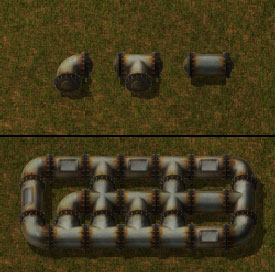Don’t do f**** up stuff like running in a circle indefinitely, sloshing back and forth endlessly etc.
This is expected real world behaviour to me. If you take a 0.6m diameter pipe that is 10m long and exactly horizontal and half fill it with water, then suddenly add 10 litres of water at one end then I expect that will setup a wave that will slosh back and forth until friction dissipates it. The reason you don't tend to see it in the real world is that normally such a pipe would be either not horizontal (eg a drain which has a deliberate downhill slope so water will always flow one way) or the pipe is 100% full of a fluid that is either stationary or moving at a fairly steady rate. (Look up water hammer for what can happen when a moving fluid suddenly stops in a pipe), or something like a hose where the flow of water is limited by the pressure difference between the entrance to the hose and the exit from the hose, and the friction caused by water flowing through the hose.
I can't recall a single instance of Factorio pipes doing "f**** up stuff like running in a circle indefinitely" that isn't a factory design issue that can be solved by something simple like not building a circular pipe network, using a pump to pressurise the pipe, making sure that supply equals or exceeds demand and that you aren't running into pipe throughput limits.
The same tactics also solve problems with junctions. If supply exceeds demand, (and you aren't running into pipe throughput limits) then pipes will be 100% full and the correct amount of fluid will take each branch of a junction. If supply doesn't at least equal demand, then that is a factory design issue to solve. Yes, better splitting at junctions would be nice, but in practice I've only ever seen issues when the fluid supply is insufficient either due to not enough production or pipe throughput limits. In which case better junction behaviour does nothing to address the root cause problem. (I will admit that the current junction behaviour might make people think the junction behaviour is a problem, but the root cause is not enough supply to meet demand). Note that in the Real World pipes tend to be either 100% full or something like a drain.









